
吃驚 BIKKURI
2010年10月23日(土)~11月21日(日)
ソン・サンヒ
SONG Sanghee
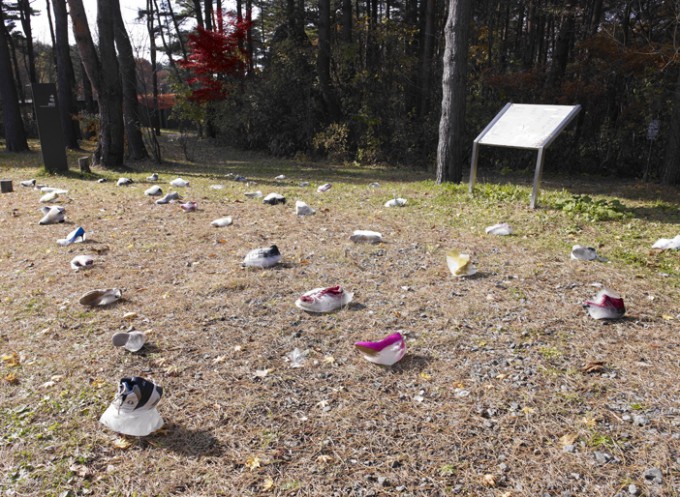
《1983》
サバルタンを想う
近藤 由紀
独立記念日の記念式典。壇上には演説する大統領らしき人物。演説の途中、突然暴漢が大統領に銃を乱射する。大統領はとっさに身をかがめ難を逃れるが、壇上に列席していた美しい薄桃色のチマ・チョゴリを着た女性は銃弾に倒れ、その実行犯もまたSPの放った銃に倒れる。だが数秒ののち、彼らは目が覚めたかのように単なる演者の顔に戻り、起き上がり、居住まいを正し、起点に戻る。この短い幕間ののち、再び同じシーンが延々と繰り返される。これは1974年8月15日の朴正熙大統領暗殺未遂事件の場面を下敷きにしたソン・サンヒの映像作品《国立劇場》(2004年)(fig.1)である。朴大統領の暗殺未遂事件という歴史的、政治的背景をもつ題材、そしてソン自身がこの作品において凶弾に倒れた陸英修大統領夫人――彼女はその生前の献身的な態度と政治的手腕および悲劇の女性という点から韓国の理想的な女性として美化され、現在もその影響力を誇っている――を演じていたこともあり、この作品は社会的政治的内容とフェミニスム的内容を併せ持った作品として注目を集めた。こうした韓国固有の歴史的、政治的、社会的内容を直接的に扱う作品は、一方で彼女と同様に1990代に台頭してきた他の韓国のアーティストたちにも共通する特徴でもあった(1)。
ソンの作品には歴史や社会的な問題を取り上げた作品が多い。さらにそこにはしばしば「女性」というモチーフが使われ、その視点が強調されている。《良い娘になるための身振り―着席のための行儀のよい姿勢》(2001年)(fig.2)では、「良い娘としてのしぐさ」強制機によって訓練された女性像が示され、それにより教養やマナーといった「淑女の嗜み」は、一方で女性が暗黙裡に家庭あるいは社会からほとんど機械的に「強要」された所作であることを明らかにしている。《トンドゥチョン(東豆川)》(2005年)(fig.3)では、政治的な背景のある町に暮らす女性に焦点をあてる。タイトルは、朝鮮戦争後米軍が駐屯し続けている行政区の名であり、米軍用の売春街のある場所でもあるという。ソンはこの作品において目と口にテープを張って街を歩くパフォーマンスを行い、立場的にも性的にも弱い存在としてこのような特殊な地域に生きる女性たちの存在の危うさを描き出す。とはいえ駐屯軍の問題を米軍対地元韓国の対立にだけとどめておこうとはしない。《メヒャンリ(梅香里)》(2005年)(fig.4)もまた米空軍に射爆場とされた土地の名である(2)。しかしここでは米軍による誤爆や犯罪問題を取り上げるのではなく、こうした問題に対立する際に浮上する民族主義を批判的にとらえる。最初の場面では制服の少女たちは韓国の民族主義の象徴としての弓矢を空(空軍)に構えている。だが次の画面では彼女たちは自分たちが放ったその矢によって殺される。彼女たちは外的な政治力のみならず、実は内的な政治力のもとでも抑圧され、その小さな声をかき消されているとでもいうように。
このようにソンは作品において、ある特定の主義や立場を声高に主張するというよりは、「世の中を動かしている人ではなく、世の中に動かされている人々」(3)に着目し、歴史の陰に忘れ去られたものたちの声を作品によって拾い上げようとする。そしてそうした人々、環境、時には動物たちの声を照射するために、ソンは現実の出来事を下敷きにすることである種のリアリティをもたせながらそこに架空の物語を重ねることで、一つのパラレルワールドを作り出す。そしてその主役/主体を変えることで異なる物語と異なる感情があることを暗示する。さらにソンは、そうした「歴史」を作る社会のシステムにも批判的な視線を向ける。それは個別的な事象の語り口を借りながら、社会や歴史の構造について向けられた眼差しであるといえるだろう。冒頭の《国立劇場》にしても、あたかもアンディ・ウォーホルの《惨事》のシリーズのように事件の場面を繰り返し演じることで、「大統領夫人の悲劇」を強調するというよりはむしろ、「惨劇」の現実感を薄めている。それはTVカメラによって収められた殺害の場面が繰り返し放映されることで、推測の域を出なかった状況説明が人々の中で断定的「真実」として根付き、悲惨な死が現実味のない一種のショーと化し、軽薄に変化していく様子と重ねられるだろう。
今回国際芸術センター青森で発表されたプロジェクトとしての作品《1983》にも、この両方の視点が表れている。物語のベースは大韓航空機追撃事件である。1983年9月1日、大韓航空007便は、サハリン西側のソ連飛行禁止区域の上空でソ連軍の追撃ミサイルによって撃墜され、乗員乗客全員が亡くなった。当時は冷戦の緊張関係の最中であり、全ての情報が隠ぺいされた。韓国政府の粘り強い交渉ののち、ようやく返還されたものは氷漬けの靴のみであったという。
今回の作品はこの「物語」が下敷きになっているのだが、それは一つのモチーフに過ぎないだろう。《1983》を構成したものは、手書きのドローイングによるコラージュ作品、映像作品《全ての人々に平和を》、ラジオを模した音の作品《121.5 Mhz》そしてラッピングされ氷づけされた靴のインスタレーションである。ACACの森へ向かう道の手前におかれた氷付けの靴は直接的に犠牲者たちの遺品を指していると同時に、大きな力によって不可抗力で破壊され、その事実すら政治の闇の中に葬られてしまったあらゆる彷徨える魂の象徴でもある。その向かいには古びたラジオが置かれ、自動的にチューニングを始めるこのラジオからは、日本、韓国、米国、ロシアなどの80年代のポップソングに交じって、女性の悲痛な叫び声やアメリカ大統領の演説、飛行機が墜落したことを伝えるロシア語のニュースなどが流れてくる。わざとらしく古めかしいラジオや時代を感じさせるポップソングたちは、今となってはそれが風化した出来事であることを強調する。当時のドキュメントを再現した手書きドローイングによるコラージュ作品は、その筆致の残る鉛筆の線と描かれた図像のおどおどした写実性によってどこか戯画的で嘘っぽくみえる。ここではラジオ作品とコラージュ作品に共通する懐古趣味や作為性によって《国立劇場》と同様に、歴史や私たちの前に明らかにされた「事実」の人工的な側面を露わにし、悲劇すら消費し、たやすく忘れてしまう大衆社会の危険性を思わせる。
《全ての人々に平和を》で映し出されている低い視点はその靴の視点である。場所は青森県下北半島の恐山。靴は古くから人々にあの世とこの世が重なる場所と思わせた独特の風景の中を歩き回っている。映像の下には対話のように詩が浮かぶ。これは8世紀の韓国の漢詩の詩人チェ・チウォン(崔致遠)の「雙女墳傳記」であり(展示の際には日本語訳された)、忘れさられた路傍の墓の前で一人の男が無念を抱える死者の魂と出合い、酒を酌み交わし、一夜を共にする物語が綴られている。一方で靴が歩き回る恐山は死者の魂が集まると信じられており、生者はここに死者との対話を求め、彼らの魂を慰めるために訪れる信仰の山である。ソンはこの靴をモチーフに滞在期間中に更に映像作品を制作した(会期中は未発表。途中経過がレクチャー時に紹介された)。そこでは身を寄せ合うように孤独に漂う靴、すなわち死者の魂たちが、広く、暗い海に漂う映像が収められていた。死の世界を彷徨い、現実の海に漂う靴たちは、どこに行き着くのだろうか。そして語る機会を得ることはあるのだろうか。ソンはこれらに言葉を与えることはないが、その存在とその言葉がある(あった)ことを幾重にも重ねた物語によって暗示させる。
「(略)B君がある夜、突然、故郷の話を目を輝かせて話しはじめ、ことに母親の手作り料理の自慢話になると、あの寡黙な彼がどうしたのか、と驚くほど饒舌になり、際限なく語り続けて、いささかヘキエキした。翌朝、朝寝坊の彼を起こそうとベッドの側にゆくと、永遠の寡黙の世界へと旅立っていった」(久永強≪戦友を送る・冬≫、1992年に添えられた詞(シベリア・シリーズ)より)(4)。
歴史が本当に血肉に刻み込まれるのは、大きな物語からこぼれ落ちたわが身に密接な出来事とその感情の積み重ねによるのではないだろうか。とすればソンが女性性を繰り返し使っていたのは、それが我が身に密接な出来事であったからであろう。それは薄い皮膜を重ねることでようやく輪郭を表してくるような、歴史を作り社会を動かす言語方法とは別の方法によってようやく浮かび上がってくる。いずれにせよそれは大きな力によって不可抗力で破壊された小さな叫びを、芸術の力によって拾い上げようとするものである。
------------------------------
(1) Joan KEE, “What is feminist about contemporary Asian women’s art?”, Global Feminisms: New directions in contemporary Art, Brooklyn Museum, New York, 2007, p.118-120 (catalogue).
(2) 実弾による訓練のため住民の負傷や家屋の損壊が相次ぎ、デモや補償問題がたびたびおこった。2005年に返還された。
(3) ソン・サンヒレクチャー「サバルタンは語ることができるか―自作について」(2010年11月20日)での発言。レクチャータイトルは、西洋の諸言説と従属的地位におかれている女性(=サバルタンの女性)について語ることの可能性との関係についての分析を行ったG.C.スピヴァクの著作に由来する。
(4) 『コレクション10年の歩み 素朴と芸術』、世田谷美術館、1996年、184頁(カタログ)。第二次世界大戦中、シベリア抑留経験のある久永は、その悲惨な体験を伝えるために突如シリーズ作品を描いたのだが、それぞれの作品には短い詞が書き添えられている。
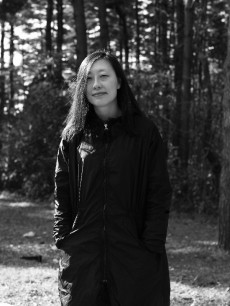
撮影:山本糾

fig.1 《国立劇場》シングルチャンネルビデオ、13分、2004年。

fig.2 《良い娘になるための身振り―着席のための行儀のよい姿勢》C-プリント、2001年。
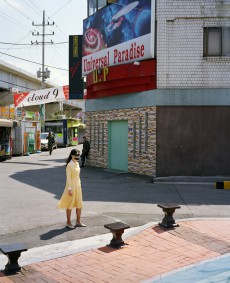
fig.3 《トンドゥチョン(東豆川)》C-プリント、2005年。
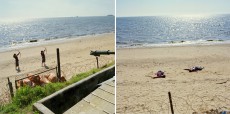
fig.4 《メヒャンリ(梅香里)》C-プリント、2005年。
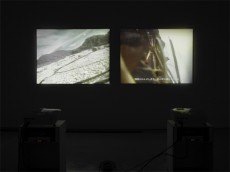
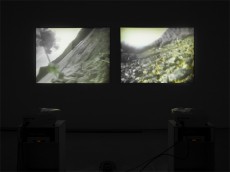
《世界の全ての人々に平和を》ビデオインスタレーション(《1983》(プロジェクト)より)
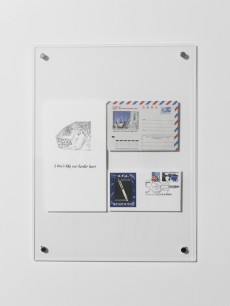

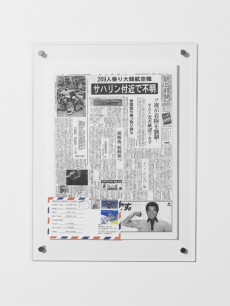


《1983》(プロジェクト)
吃驚 BIKKURI
October 23 -- November 21, 2010.
SONG Sanghee
ソン・サンヒ

1983 photo: YAMAMOTO Tadasu
Subaltern
KONDO Yuki
The ceremony of Independence Day in Korea. A man, presumably the President, is giving a speech onstage. In the midst of the speech, a thug suddenly fires his gun towards the President. The President promptly ducks and escapes danger, but a woman in a beautiful pink chima jeogori (traditional Korean clothing) who was on the stage gets shot, as well as the perpetrator, who is gunned by an SP. However, after a few seconds, their expressions return to those of mere actors, and they get up, straighten themselves, and go back to the beginning. After this brief interval, the same scenes get repeated on and on. This is The National Theatre (2004) (fig. 1), a video art piece by SONG Sanghee that is based on the attempted assassination of President PARK Chung-hee on August 15, 1974. Due to the historic and political background of the motif, and the fact that Song herself played the role of First Lady YUK Young-soo--she was beautified as the ideal Korean woman because of her devoted attitude and political capability in life and being a tragic heroine, and her influence still endures--this work gained attention as having both social/political and feministic content. Such works that directly deal with historic/political/social content unique to Korea were also a common characteristic shared with other Korean artists that became prominent in the 1990s like her.(1)
Song's works often deal with historic and social issues. Additionally "women" are frequently used as a motif, and emphasis is put on their perspective. In Gesture to be a Good Daughter--Proper Posture for Sitting (2001) (fig.2), the images of a woman trained with a "Gesture to be a good daughter" forcing machine are presented, and it is shown that "ladylike behavior", such as culture and manners, is tacitly and almost mechanically "enforced" on women by their families or society. Dongduchun (2005) (fig. 3) focuses on a woman living in a town with a political background. The title is the name of an administrative district where the US Army has been stationed since the Korean War, and it is also the location of a red-light district for the US Army. In this work, Song did a performance in which she stuck tape on her eyes and mouth and walked the streets, and depicted the women living in such special regions as existence both politically and sexually frail. Yet she does not keep the issue of the garrisons merely to an opposition between the US Army and Korea. Maehang-ri (2005) (fig. 4) is the name of an area turned into a shooting-bombing range by the US Air Force.(2) However, instead of picking up the Army's accidental bombings or crime problems, she critically examines the nationalism that uprises in opposition to such issues. In the first scene, the girls in uniforms are aiming their bows, as the symbol of Korean nationalism, towards the sky (the Air Force). But in the next scene they are killed by the arrows that they themselves shot. It is as if they are oppressed not only by external but also internal political powers so their low voices being drowned out.
As can be seen, rather than advocating certain beliefs or positions, Song takes notice "not of people who move the world, but people who are moved by the world"(3), and through her work she attempts to pick up the voices of those who are forgotten in the shadows of history. In order to make the voices of those people, environments, and occasionally animals heard, Song uses real incidents as a model to maintain reality but also layers fictional stories, creating a kind of parallel world. By changing the leading role/subject of that world, she implies that there are different stories and different emotions. That also turns a critical perspective towards the social system that creates "history" as such. It can be said that that is a gaze towards the structure of society and history even though it borrows the narrative of individual phenomenon. Even in The National Theatre, rather than focusing on the tragic First Lady, by repeatedly performing the scene of the incident, she weakens the sense of reality and suggests its manipulativeness, just like Andy WARHOL's "Disaster" series. That can be compared to the manner that, as murder scenes filmed by TV cameras get broadcasted repeatedly, the accounts of situations that were merely surmises root among the people as conclusive truth, and tragic deaths frivolously turn into a show of sorts that lacks reality.
These two perspectives are also shown in her project 1983 that has been released at ACAC on this occasion. The base of the story is the Korean Air Lines Flight 007 Incident. On September 1st, 1983, Korean Air Lines Flight 007 got shot down in a Soviet no-fly zone at the west of Sakhalin by Soviet homing missiles, and all crew members and passengers died. Amidst the tense relations of the Cold War, all information was concealed. It is said that even after tenacious negotiations by the Korean government, all that was finally returned were frozen shoes.
1983 is based on this "story", but perhaps it is merely one of several motifs. What composes this work is a collage of drawings made by hand, a video piece titled Peace to all people in the world, a sound piece titled 121.5 Mhz which is an imitation of a radio, and an installation of wrapped and frozen shoes. The frozen shoes, which are placed before the path leading to ACAC's forest, directly refer to what was left by the victims, and at the same time also symbolizes all stray souls that were inevitably destroyed by a strong force, with even that fact itself being hushed up in the shadows of politics. On the opposite side is a radio that automatically tunes itself, playing the grievous screams of women, a speech by the US President, and a Russian news broadcast reporting that a plane has crashed along with Japanese, Korean, American and Russian pop songs from the 1980s. The exaggeratedly old-fashioned radio and the faded pop songs that are reminiscent of the past emphasize that the incident has been weathered now. The drawing-collage, a reproduction of documents from back then, looks somewhat comical and phony due to the timid realism of the pencilled lines with their touches remaining and the images that are drawn. Through the nostalgia and artificiality that is shared with the radio and the collage, the piece reveals the artificial aspect of history and the "facts" that are clarified before us, and evokes the danger of popular society, where even tragedies are consumed and easily forgotten, just like The National Theatre.
The low-angled perspective projected in Peace to All People in the World is that of the shoes. The video is set in Osorezan in Shimokita Peninsula, Aomori. The shoes are walking around the unique scenery that people thought to be where this world and the other world overlap since ancient times. Beneath the images, a poem appears like a conversation. This is a story written by the 8th century Korean poet of Kanshi [Chinese] poetry CHOE Chiwon (translated to Japanese for the exhibition), which depicts the story of a man who meets a resentful dead spirit in front of a forgotten grave beside a road and spends the night together drinking. Osorezan in Aomori Prefecture, where the shoes are walking around, is a mountain of worship, which is believed to be where dead spirits gather, and where the living visit in order to talk with and console the dead. During her stay, Song produced further video work using the shoes as a motif (not exhibited as of the period of the exhibition. Progress was reported during her lecture). In the video, the images of shoes, or in other words dead spirits, drifting together in solitude on a wide, dark sea, were captured. After wandering the afterworld and drifting on the sea of reality, where will the shoes arrive? Will they ever have the opportunity to speak? Song cannot give them words, but through a multilayered story, she implies that they have (or had) their own existences and words.
"…One night, B suddenly started to talk with shining eyes about his hometown, and especially when he was bragging about his mother's cooking, he became so talkative that it made me wonder what happened to his usual quietness. He talked on and on, and I got fed up. The next day, when I went up to his bed to awaken him, a late riser, he had already gone to the world of eternal silence" (HISANAGA Tsuyoshi, Burying a Comrade’s Remains -- Winter, from words written for his Siberia Series in 1992).(4)
Is it not through the piling of incidents that fell nearby from a grand story and the emotions provoked that history truly gets inscribed into our blood and flesh? If that is so, then the reason why Song repeatedly incorporated femininity must be because that was an incident that was intimate to her. That finally becomes apparent by a method different from the lingual method of making history and moving society, as if its outlines become apparent after layering thin films. All the same, it is something that tries to pick up frail screams inevitably destroyed by strong forces, using the power of art.
---------------------------
(1) Joan KEE, “What is feminist about contemporary Asian women’s art?”, Global Feminisms: New directions in contemporary Art, Brooklyn Museum, New York, 2007, p.118-120 (catalogue).
(2) A lot of Korean citizen and their houses were harmed by the military drills in which real bullets were used so demonstration and compensation issues often took place. The region was returned to Korea in 2005.
(3) From Song’s Lecture titled “Can Subaltern Speak?” November 20, 2010. This title is derived from the book by critic Gayatri SPIVAK in which she discusses the relationship between Western discourses and the possibility to speak for subordinated (=subaltern) women.
(4) From the Collection Naivety in Art: A Decade of Exploration, Setagaya Art Museum, 1996, p.184. Hisanaga, former POW in Seberia during the World War II, suddenly began painting and depicted Siberia Series long after the war to convey his severe experience.

photo: YAMAMOTO Tadasu

fig.1 The National Theatre, Single channel video 13min., color/ sound, 2004.

fig.2 Gesture to be a good daughter--proper posture for seating, C-print, 2001.

fig.3 Dongduchun, C-print, 2005.

fig.4 Maehang-ri, C-print, 2005.


Peace to all people in the world (work in progress), video installation, 2010. (from project 1983)





project 1983
